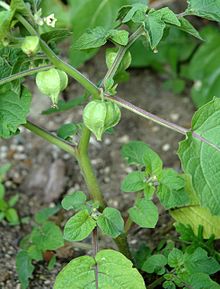Physalis pruinosa
| Physalis pruinosa | |
|---|---|

| |
| Scientific classification | |
| Kingdom: | Plantae |
| Clade: | Tracheophytes |
| Clade: | Angiosperms |
| Clade: | Eudicots |
| Clade: | Asterids |
| Order: | Solanales |
| Family: | Solanaceae |
| Genus: | Physalis |
| Species: | P. pruinosa
|
| Binomial name | |
| Physalis pruinosa | |
Physalis pruinosa is a plant in the genus Physalis in the nightshade family Solanaceae, often referred to as ground cherry or husk tomato. It is a native species in a range extending from northern Mexico through Central America.[1] The plant has a low, spreading habit, and fruits develop in a papery husk, as is characteristic of the genus. While most parts of the plant are toxic to humans due to the presence of solanine and solanidine,[2] the fruit becomes edible (and sweet) once it has ripened to yellow. (The papery husk, a calyx, remains toxic and should not be eaten.) The fruit's flavor is similar in some respects to that of a ripe tomatillo, but notably has a strong flavor of pineapple as well, a fact reflected in the name of a common commercial variety, "Cossack Pineapple". The ripe fruit of Physalis pruinosa var. argentina J. M. Toledo & Barboza is a food source for the Pilagá ethnic group.[3]
It is currently the subject of research into the possibility of developing a genetically modified variety for industrialized agriculture.[4] The research involves CRISPR genome editing which may be able to accelerate the domestication process.[5]
References[edit]
- ^ USDA National Plant Germplasm System
- ^ Ground Cherry Ripeness, answers from a Hennepin County Master Gardener, July 13, 2019
- ^ Arenas, Pastor; Kamienkowski, Nicolás Martín (December 2013). "Ethnobotany of the Genus Physalis L. (Solanaceae) in the South American Gran Chaco". Candollea. 68 (2): 251–266. doi:10.15553/c2012v682a9. hdl:11336/8358. ISSN 0373-2967.
- ^ "This Wild Plant Could Be the Next Strawberry", Research News release, Howard Hughes Medical Institute, October 1, 2018
- ^ Dockrill, Peter. "Meet The Weird Fruit That Could Soon Become as Common as a Strawberry". ScienceAlert. Retrieved 2018-10-02.
